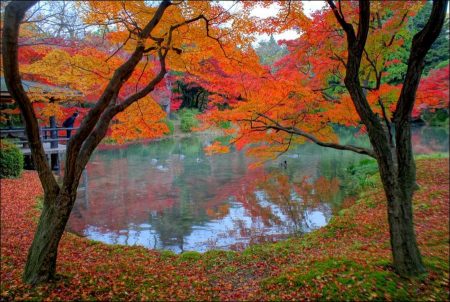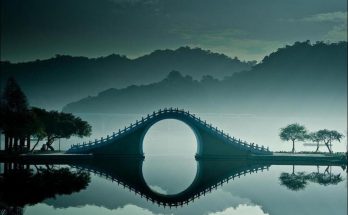One of the principal things to be pointed out at any one of these great temples will be its landscape gardens, the charm of which would increase if you knew something of its history and significance. The soul of a Japanese garden is in its imitation of nature, or reproduction, within a narrow space of the beauty and variety, of nature’s limitless landscape. It derives no inspiration from the mere utilitarian desire for shade, fruit and promenade.
As in painting one would compress on to a small canvas a whole region of natural landscape, so is a Japanese “niwa” (garden) a replica in miniature of the depths and solitude of a great mountain, the picturesqueness of its rivers and cataracts, the pathless profusion of primitive forests, and other attributes of nature’s scenic phenomena. Hence the indispensability of a hill, a pond and stone-lanterns, symbolical of temples or rural habitations.
The art of gardening came from China in the wake of Buddhism, and its Buddhist significance became accentuated during the Kamakura period, when the contemplative Zen Sect gained a strong foothold. Instead of retiring into the mountains, the priest might create in his garden the same effect of being remote from the world. Thus, the first garden artist was a priest. Later in the Ashikaga period it passed into the hands of tea-masters. Then it became an indispensable part of the tea-room which must have an unworldly atmosphere. A celebrated garden-artist of this period was Sōami, to whom are ascribed some of the oldest and best gardens — those of Kinkakuji and Nishi Hongwanji. Rikyū, the greatest name in tea ceremony, was also noted for his skill in gardening.
Later in the Tokugawa era the art passed into the hands of special gardeners, but Kobori Enshū, who was a great tea-master, was also distinguished as a gardener. His handiwork may be seen today in the gardens of Daitokuji, Kōdaiji, Nanzenji, Chionin. But by far the most famous of his works was the garden now seen in the Imperial Detached Palace of Katsura which you can visit by permit of the authorities concerned.
This was a palace built by Hideyoshi for one of the Imperial princes, and Kobori Enshū had, it is said, extracted the promise from the Taikō that no limit was to be put on time or money, and that he was not to be interfered with in his work. The result was a marvel of landscape gardening, which, being laid as it was on dry level ground, not far removed from city life, had all the air of remoteness and deep sylvan stillness and solitude.
Landscape gardening was responsible for several minor but perhaps equally difficult arts of diminutive gardens, often seen in Japanese homes, “bonkei” (tray gardens), “bonseki ” (stone-and-sand gardens represented on trays), “bonsai” (dwarf trees), of which you can see perfect specimens in Kyoto as in most other parts of Japan.
If you are interested in old mansions, combining the archaic style of wooden architecture and the classic beauty of landscape gardening, you must by no means miss the Detached Palace of Shugakuin, which covers an extensive area of ground, affording good scope for walking. There are three huts, upper, lower and middle, with winding gravel paths in between, commanding lovely views of the surrounding plains and mountains. Many precious paintings and other things of artistic value are kept here.
Views: 215




